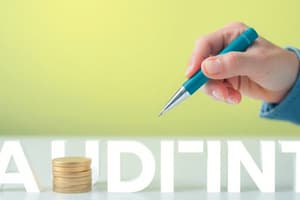Podcast
Questions and Answers
What does the acronym ALARA stand for?
What does the acronym ALARA stand for?
- As Low As Rigorously Attainable
- As Low As Responsibly Attained
- As Low As Reasonably Achievable (correct)
- As Low As Realistically Achieved
Which of the following is NOT one of the four risk response strategies?
Which of the following is NOT one of the four risk response strategies?
- Avoidance
- Retention
- Transfer
- Mitigation (correct)
Which tool is primarily used for assessing the inherent risk at each step of a work process?
Which tool is primarily used for assessing the inherent risk at each step of a work process?
- Loss Control Measures
- SWOT analysis
- Root Cause Analysis
- Job Safety Analysis (JSA) (correct)
What does the Domino Theory suggest about the cause of accidents?
What does the Domino Theory suggest about the cause of accidents?
Which risk financing technique involves generating funds to pay for potential losses?
Which risk financing technique involves generating funds to pay for potential losses?
What is the main focus of risk-based auditing?
What is the main focus of risk-based auditing?
Which of the following is NOT an objective of risk management?
Which of the following is NOT an objective of risk management?
What is the primary function of underwriting?
What is the primary function of underwriting?
What do staff underwriters NOT typically do?
What do staff underwriters NOT typically do?
What knowledge is essential for successful underwriters?
What knowledge is essential for successful underwriters?
What does the term 'moral hazard' refer to?
What does the term 'moral hazard' refer to?
Which aspect is crucial to examine in a property application by underwriters?
Which aspect is crucial to examine in a property application by underwriters?
What does the 'S' in the 5-S housekeeping technique represent?
What does the 'S' in the 5-S housekeeping technique represent?
Which of the following is a financial consideration in risk management?
Which of the following is a financial consideration in risk management?
What does a combined ratio of less than 100 indicate?
What does a combined ratio of less than 100 indicate?
Which statement correctly describes reinsurance?
Which statement correctly describes reinsurance?
What is the primary concern in underwriting?
What is the primary concern in underwriting?
What does the term 'hit ratio' refer to in underwriting?
What does the term 'hit ratio' refer to in underwriting?
Which method is NOT used in qualitative risk assessment?
Which method is NOT used in qualitative risk assessment?
In risk assessment, what does ARO stand for?
In risk assessment, what does ARO stand for?
Which of the following is a step in the EPA Human Health Risk Assessment?
Which of the following is a step in the EPA Human Health Risk Assessment?
What is the primary concern for underwriters in umbrella and excess liability underwriting?
What is the primary concern for underwriters in umbrella and excess liability underwriting?
What does facultative reinsurance allow the primary insurer to do?
What does facultative reinsurance allow the primary insurer to do?
Which element is a method for analyzing future loss potential in catastrophic scenarios?
Which element is a method for analyzing future loss potential in catastrophic scenarios?
What are underwriting guidelines primarily used for?
What are underwriting guidelines primarily used for?
What does a hazard refer to in the context of insurance?
What does a hazard refer to in the context of insurance?
What does retrocession involve?
What does retrocession involve?
Which of the following best describes catastrophe insurance?
Which of the following best describes catastrophe insurance?
What is the purpose of premium audits?
What is the purpose of premium audits?
According to the Human Factors Theory, which category covers inappropriate activities leading to accidents?
According to the Human Factors Theory, which category covers inappropriate activities leading to accidents?
What role does telematics play in insurance?
What role does telematics play in insurance?
What type of insurance is designed for low-probability, high-cost events?
What type of insurance is designed for low-probability, high-cost events?
Which term refers to the risk or amount of insurance a company decides not to retain?
Which term refers to the risk or amount of insurance a company decides not to retain?
What are the three broad categories identified in the Human Factors Theory by David Yates?
What are the three broad categories identified in the Human Factors Theory by David Yates?
Who is primarily responsible for conducting an incident investigation?
Who is primarily responsible for conducting an incident investigation?
What is the most commonly used systems safety analysis technique?
What is the most commonly used systems safety analysis technique?
What is the process of identifying hazards and recommending risk reductions called?
What is the process of identifying hazards and recommending risk reductions called?
Which reasoning approach is characterized as going from specific to general?
Which reasoning approach is characterized as going from specific to general?
What does Fault Tree Analysis (FTA) primarily focus on?
What does Fault Tree Analysis (FTA) primarily focus on?
What term describes the chance or probability of occurrence of an injury or loss?
What term describes the chance or probability of occurrence of an injury or loss?
Which option best defines an incident in the context of workplace safety?
Which option best defines an incident in the context of workplace safety?
Flashcards
Risk-Based Auditing
Risk-Based Auditing
A process that prioritizes using an organization's limited resources to focus on areas posing the greatest risk.
Risk Management Objectives
Risk Management Objectives
The practice of balancing risk and reward, complying with regulations, and ensuring business survival and growth.
Underwriting
Underwriting
The process of selecting and classifying insureds, determining rates, and managing a book of business for insurers.
Rating
Rating
Signup and view all the flashcards
Moral Hazard
Moral Hazard
Signup and view all the flashcards
Property Application
Property Application
Signup and view all the flashcards
Essential Knowledge for Underwriters
Essential Knowledge for Underwriters
Signup and view all the flashcards
Risk Assessment
Risk Assessment
Signup and view all the flashcards
Loss Prevention
Loss Prevention
Signup and view all the flashcards
Risk-Based Prioritization
Risk-Based Prioritization
Signup and view all the flashcards
Risk Retention
Risk Retention
Signup and view all the flashcards
Root Cause Analysis
Root Cause Analysis
Signup and view all the flashcards
Rating Plan
Rating Plan
Signup and view all the flashcards
Risk Control
Risk Control
Signup and view all the flashcards
Combined Ratio
Combined Ratio
Signup and view all the flashcards
Retention Ratio
Retention Ratio
Signup and view all the flashcards
Qualitative Risk Assessment
Qualitative Risk Assessment
Signup and view all the flashcards
Reinsurance
Reinsurance
Signup and view all the flashcards
Quantitative Risk Assessment
Quantitative Risk Assessment
Signup and view all the flashcards
Single Loss Expectancy (SLE)
Single Loss Expectancy (SLE)
Signup and view all the flashcards
Catastrophe Insurance
Catastrophe Insurance
Signup and view all the flashcards
Retrocession
Retrocession
Signup and view all the flashcards
Human Factors Theory
Human Factors Theory
Signup and view all the flashcards
Vicarious Liability
Vicarious Liability
Signup and view all the flashcards
Hazard Analysis
Hazard Analysis
Signup and view all the flashcards
Preliminary Hazard Analysis (PHA)
Preliminary Hazard Analysis (PHA)
Signup and view all the flashcards
Inductive Reasoning
Inductive Reasoning
Signup and view all the flashcards
Deductive Reasoning
Deductive Reasoning
Signup and view all the flashcards
Fault Tree Analysis (FTA)
Fault Tree Analysis (FTA)
Signup and view all the flashcards
Underlying Insurer
Underlying Insurer
Signup and view all the flashcards
Loss Analysis
Loss Analysis
Signup and view all the flashcards
Loss Severity
Loss Severity
Signup and view all the flashcards
Facultative Reinsurance
Facultative Reinsurance
Signup and view all the flashcards
Underwriting Guidelines
Underwriting Guidelines
Signup and view all the flashcards
Hazard
Hazard
Signup and view all the flashcards
Premium Audit
Premium Audit
Signup and view all the flashcards
Telematics
Telematics
Signup and view all the flashcards
Predictive Modeling
Predictive Modeling
Signup and view all the flashcards
Study Notes
Risk-Based Auditing
- Risk-based auditing prioritizes using limited internal audit resources in areas posing the greatest risk to the organization
- Three key principles are auditing to business objectives, focusing on materiality of risk, and identifying threats to business goals
- Risk management is used to control or contain losses and satisfy customers
- Common risk management objectives include balancing risk and reward, supporting decision-making, achieving goals such as tolerable uncertainty, legal and regulatory compliance, survival, continued business, earnings stability, profitability, growth, and social responsibility
Underwriting
- Underwriting helps insurers develop a growing, profitable book of business by minimizing adverse selection, ensuring adequate policyholders' surplus, and enforcing underwriting guidelines
- Underwriters perform tasks like selecting insureds, classifying and pricing accounts, recommending or providing coverage, managing a book of business, supporting producers and insureds, and contributing to the insurer's marketing objectives
Staff Underwriters
- Involved in market research, policy formulation, underwriting guideline revision, evaluating loss experience, developing coverage forms, reviewing rates, arranging reinsurance, supporting complex accounts, and conducting underwriting audits
- Underwriting policies guide individual and aggregate policy selection in support of insurer mission statements
Essential Knowledge for Underwriters
- Underwriters require knowledge of insurance principles, practices, loss exposures and pricing, insurance rates, loss analysis, and various internal and external information sources
Rating
- Rating involves applying an applicable rate and rating plan to an exposure and performing calculations to determine the policy premium
Moral Hazard
- Moral hazard increases the likelihood of intentional loss or exaggeration
Property Application
- Underwriters examine loss history, COPE elements, and property values in property applications
Supplemental Information
- Supplemental information such as risk management programs, financial statements, risk control reports, and property valuation guides helps underwriters assess the quality of a property account
COPE and Loss Run
- COPE elements in commercial property underwriting include construction, occupancy, protection, and external exposures
- A loss run details an insured's claims history over a specific period
Morale Hazard
- Morale hazard is carelessness or indifference that increases loss frequency or severity
Fire Protection and Division
- Underwriters analyse loss exposures from nearby properties or the surrounding area
- A fire division in a structure is well-protected and prevents fire spread to other sections.
Public and Private Fire Protection
- Public fire protection involves government-supplied equipment and services within a defined area
- Private fire protection involves property owner-implemented measures to protect from loss by fire
Residential and Occupational Loss Exposures
- Underwriters consider hazards that can increase liability losses from invited guests when evaluating residential losses
- Personal insurance applications often include questions about occupation to determine potential loss frequency and severity
Rating Plan
- Directions specifying criteria for exposure base, exposure unit, and rate per exposure unit to determine insurance premiums for a particular line
Combined Ratio
- A combined ratio under 100 indicates insurer profit from underwriting insurance; over 100 indicates a loss
Nonfinancial Measures
- Tools used to monitor underwriting results, including selection, pricing, product line mix, retention ratio, hit ratio, customer service, and premium volume
Retention Ratio
- The percentage of expiring policies an insurer renews
- Retaining policies is often more profitable than acquiring new business as previously completed work is utilized.
Hit Ratio
- Measures how well underwriters meet sales goals by comparing the number of policies written to quoted applications
Physical Controls
- Used to limit physical access to protected information or facilities (e.g., locks, fences)
Technical Controls
- Also known as logical controls, these are implemented in the computing environment (e.g., operating systems, application programs, database frameworks, firewalls)
Directive Control
- Specifies expected employee behavior through policies and guidelines (e.g., acceptable use policy)
Deterrent Control
- Discourages security policy violations through effort to circumvent policies or consequences (e.g., CCTV monitoring)
Preventative Control
- Stops a security incident (e.g., background screenings)
Compensating Control
- Mitigates risk to an acceptable level when standard protection is insufficient (e.g., acceptable agreed exceptional process)
Detective Control
- Alerts security professionals to attempted security violations
Corrective Control
- Responds to security violations, reducing or eliminating their impact (e.g., escorting unauthorized persons offsite)
Hazard
- A condition or activity with the potential for harm
Risk
- The chance or probability of injury, loss, or a hazard occurring
Incident
- An event where a work-related injury, illness, or fatality occurs/could have occurred
Risk Response Strategies
- Avoidance, transfer, retention, and reduction are four strategies for managing risks
Risk Assessment
- The overall process of identifying, analyzing, and evaluating risks
ALARA and ALARP
- Acronyms for "As Low As Reasonably Achievable/Practical"
Loss Control Measures
- Examples include hazcom training, machine guards, and confined space programs
Domino Theory
- All accidents are caused by a chain of events, and the removal of any chain of events can prevent the accident.
Peterson's Accident/Incident Theory
- Causes of accidents/incidents are human error and/or system failure
Risk Analysis vs. Risk Management
- Risk analysis: estimating risk.
- Risk management: determining acceptability and methods to reduce risk to an acceptable level.
Hazard Analysis Categories
- Three categories of hazards
Environmental Issues
- Environmental issues, inherent properties, and failures create stress, hazards, and material failures
Primary Methods for Reducing Accidents
- Two methods; Prevention and Financial (cost reduction)
Poka-Yoke
- Lean manufacturing technique to prevent errors/mistakes
Kaizen
- Japanese term for continuous improvement
5-S
- Effective housekeeping technique (Sort, Straighten, Scrub, Systematize, Standardize)
Risk Management Techniques
- Controlling risk and risk financing for losses
Risk Management
- Examining feasibility of risk management (financial/non-financial factors)
Financial Considerations
- Factors include forecasted losses, insurance types, and deductibles
Non-Financial Considerations
- Factors include business operations, customer and employee safety, and reputation
Risk Management Techniques
- Risk financing and risk control, including communication and training
- Techniques such as risk financing, risk control and risk communication
Insurance Rating Plan
- Set of directions specifying criteria for exposure base, exposure unit, and rate per exposure unit for premium calculations
Combined Ratio
- Ratio less than 100 indicates underwriting profit; more than 100 indicates underwriting loss
Non-Financial Measures
- Measures include selection, product mix, pricing, retention, hit ratio, and customer service
Retention Ratio
- Percentage of expiring policies an insurer renews
Hit Ratio
- Measuring underwriters' sales goal accomplishment
Personal and Advertising Injury Liability
- Includes false arrest, wrongful eviction, slander, libel etc
Medical Payments
- Covers necessary medical expenses for injuries on/from insured property
Real Property
- Includes land, structures, and growing assets
Ethical Principles
- Fair presentation, confidentiality, due professional care, independence, evidence-based approach, risk-based approach
Pure Risk
- Loss potential but no gain
Whole Person Theory
- Evaluating a person’s ability after an injury
Indemnity
- Benefit associated with wage replacement
Wage Loss Theory
- Method for evaluating lost wages
Life Care Plan
- Comprehensive report of medical condition/ongoing care
Residual Risk
- Risk remaining after risk treatment
Retained Risk
- Risk organization chooses to retain.
Risk Management
- Uncertainty about loss occurrence; goals to decrease frequency/severity of risk/paying for losses.
Pure Risk
- Potential for loss, but no possibility of gain (property damage, injury)
Speculative Risk
- Possible loss, no loss, or gain (investment, gambling)
Risk Assessment Methods
- Qualitative and quantitative approaches including Delphi Method, categorical/non-numeric values, and numerical historical incidents/re-occurrence
Risk Assessment Steps
- Identify hazard/risk, affected parties, impact assessment, record results, review periodically
Risk Management Guidelines
- Analysis, prioritization, response, and monitoring for risk programs.
Risk Exposure Analysis
- Identifying and analyzing an organization's risks (tools like checklists, loss histories, computer software, audits)
Risk Treatment Techniques
- Preventative methods: avoid or modify the risk
Risk Financing Techniques
- Managing funding for losses (e.g, retention, transfer)
Risk Control Techniques
- Reduce frequency/severity of losses (e.g, risk avoidance, risk modification, loss prevention)
Transfer of Risk
- Shifting financial liability to another party via contract
Personal Umbrella Policy
- Extends coverage above the limits of existing policies for large liabilities
Underwriting
- Considering underlying coverage requirements for personal umbrella insurance
Physical & Technical Controls
- Physical (locks, fences) and technical (computer systems, software, firewalls) security measures
Types of Controls
- Directive (policies/guidelines), Deterrent, Preventative, Compensating, Detective, Corrective, Recovery
Consequences (Modern Management)
- Consequences must be identified, positive/negative, immediate/future, certain/uncertain, and motivating factors
Risk (Definition/Analysis)
- Risk definition: combination of severity and probability; residual/retained risk, after risk treatment.
Analysis Techniques
- Pareto analysis (ranking severity/frequency), FMEA (failure modes and effects), FMECA (failure modes, effects, criticality analysis), FTA (fault tree analysis), FHA (fault hazard analysis), and common-cause failure analysis (CCA)
Studying That Suits You
Use AI to generate personalized quizzes and flashcards to suit your learning preferences.




